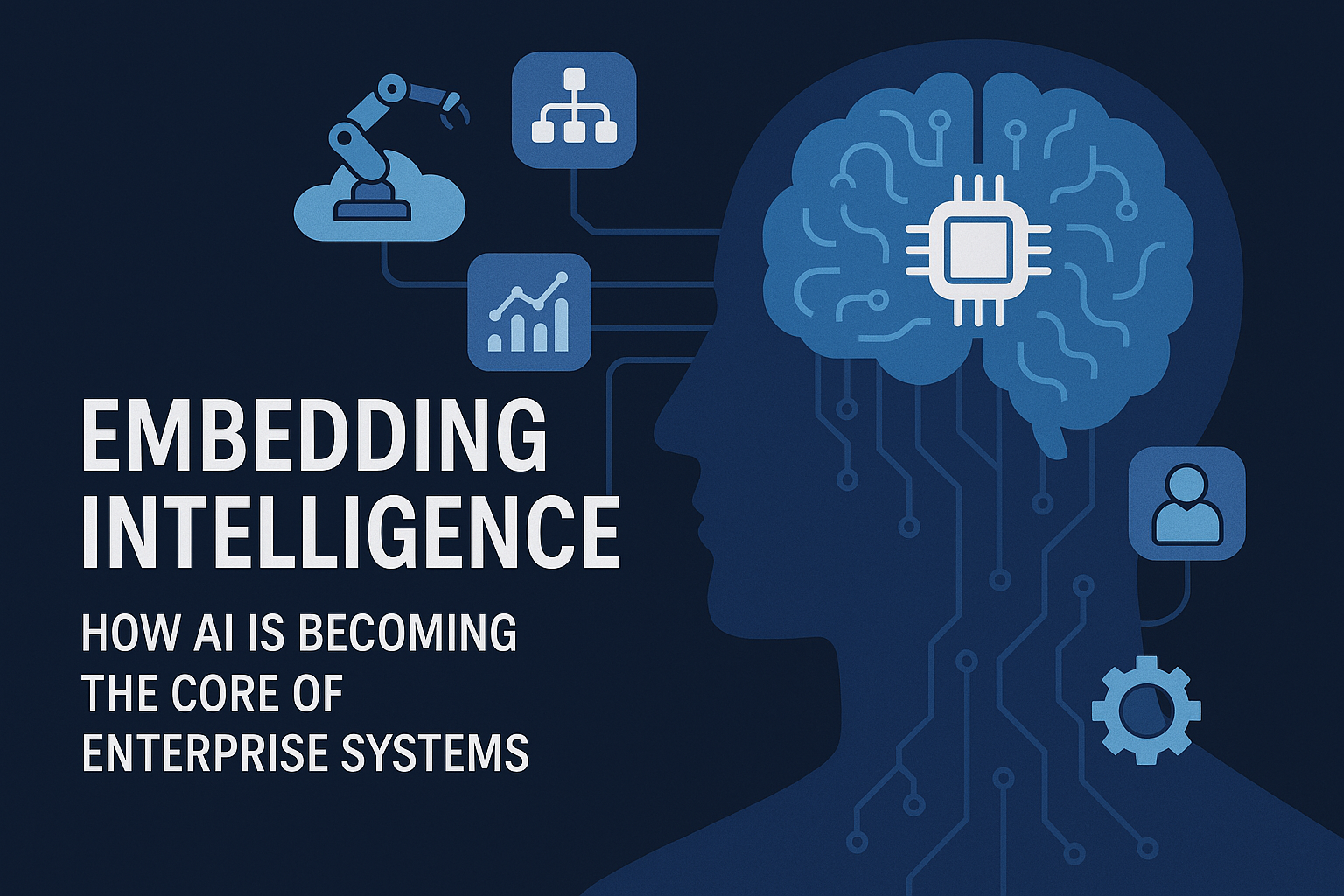Embedding Intelligence: How AI Is Becoming the Core of Enterprise Systems

Just a few years ago, AI was the shiny accessory of enterprise tech stacks—a standalone module, a chatbot here, a forecasting model there. But today, the conversation has fundamentally changed. AI is no longer layered on top of enterprise systems; it’s being embedded deep within their architecture.
This shift is profound. Enterprise resource planning (ERP), customer relationship management (CRM), human capital management (HCM), supply chain, finance, and even cybersecurity platforms are being rebuilt—not just retooled—to function as AI-native systems. Modern platforms are being designed with intelligence as a foundational capability, capable of learning from historical data, adapting to new information, and enabling real-time decision-making.
It’s not just “intelligent features”—it's AI being baked into workflows, business logic, automation layers, and data pipelines. Enterprise software vendors like Oracle, SAP, Microsoft, Salesforce, and Workday are racing to redesign their platforms with embedded machine learning and generative AI. This re-architecture is defining the next generation of enterprise software.
For CIOs and CTOs, AI integration is no longer optional—it’s a strategic imperative. It affects competitiveness, agility, employee productivity, customer satisfaction, and even compliance.
The organizations that lead with AI aren’t just automating—they’re reimagining how business is done. From shortening R&D cycles and optimizing supply chains to personalizing employee learning and accelerating cash cycles, AI impacts every core system.
Yet the path is riddled with strategic questions:
Should you rebuild core systems with AI, or extend existing ones?
Do you embed vendor-native AI or build your own models?
How do you ensure data governance, ethical compliance, and explainability?
AI demands a strategic, enterprise-wide lens—not isolated proofs of concept. Smart leaders are weaving AI into their digital transformation strategy, not treating it as an experiment.
The real power of AI lies in its versatility. Let’s explore how AI is reshaping different enterprise functions:
Finance: From intelligent cash flow forecasting to real-time anomaly detection, AI is revolutionizing finance. NLP-enabled invoice processing, predictive fraud detection, and autonomous reconciliation are becoming standard.
Supply Chain: AI forecasts demand with greater accuracy, optimizes inventory levels, and even reroutes shipments in real-time based on weather, logistics, or geopolitical factors. Generative AI now assists with contract summaries and supplier negotiations.
HR and Talent: Intelligent hiring, skills-matching engines, employee engagement insights, and AI-powered learning journeys are redefining the workforce lifecycle. AI also ensures bias monitoring and diversity analytics.
IT & Operations: Self-healing systems, anomaly detection, and AI-driven workload optimization help IT teams manage increasingly complex environments. AI agents are also emerging in helpdesk automation and incident resolution.
Customer Experience: AI personalizes marketing campaigns, predicts customer churn, automates support with agents, and generates dynamic product recommendations. GPT-like assistants are the new front lines of engagement.
No AI without data. And no effective enterprise AI without unified, well-governed, accessible data.
Enterprise systems have historically operated in silos. Finance data lived in one place, sales data in another, supply chain in yet another. AI can’t function meaningfully in this fragmented world.
This is where data platforms like SAP Business Data Fabric, Oracle’s Fusion Data Intelligence, and Snowflake’s enterprise data cloud come in. These platforms unify data across domains and enable real-time AI analytics. Retrieval-augmented generation (RAG) frameworks allow generative AI to tap structured and unstructured data—documents, systems, logs—ensuring grounded, relevant outputs.
In short: data strategy = AI strategy. CIOs must ensure master data management, metadata lineage, and data availability to make AI actionable across the enterprise.
While early enterprise AI focused on automation and prediction, generative AI is shifting the paradigm. It brings reasoning, content generation, and contextual understanding into the enterprise.
Tasks that once required human writing—RFQ summaries, performance reviews, training guides—can now be generated. More importantly, GenAI understands the context: it knows the customer history, the purchase order, the KPI framework, the security policy.
This isn’t just about producing more content—it’s about accelerating decision velocity. Employees can ask natural language questions across ERP systems (“Why did revenue dip last quarter in EMEA?”), get synthesized answers with charts, and drill into root causes—all without writing a single query.
Generative AI becomes the interface between humans and the enterprise stack. Think of it as the universal translator of business logic.
AI integration isn’t just a tech challenge—it’s a delivery model challenge. Enterprise teams often lack the skills, bandwidth, or cross-domain expertise to implement AI meaningfully. This is where the AiDOOS Virtual Delivery Center (VDC) model shines.
The VDC is not a staff augmentation model. It’s a structured execution layer where expert teams deliver AI-infused enterprise transformation through a cloud-based, project-on-demand setup. From upgrading ERPs with GenAI capabilities to embedding intelligent agents in supply chain systems, VDCs bring execution excellence at scale.
With VDCs:
AI pilots don’t die in the lab—they scale.
Enterprise systems don’t break—they evolve.
Internal teams don’t stretch thin—they stay focused.
This model is especially crucial as enterprises face a severe talent crunch in AI, data science, and cloud architecture.
AI integration is not without hurdles. Among them:
Ethical Risks: AI may hallucinate, introduce bias, or generate IP-complex content.
Data Challenges: Dirty, sparse, or siloed data derails model performance.
Organizational Change: Embedding AI means rethinking roles, processes, and KPIs.
Vendor Lock-in: Enterprises must assess how tightly AI capabilities are coupled to platforms—and plan for portability.
Cost Visibility: GenAI inference costs can spike unpredictably. Budget forecasting needs recalibration.
The biggest risk? Shallow adoption. Without aligning business goals, change management, and robust evaluation, AI becomes a flashy dashboard, not a transformation lever.
We’re entering an era where AI isn’t a feature—it’s the new operating layer of enterprise software. The most successful organizations won’t be those who merely adopt AI tools. They’ll be the ones who re-engineer their systems, workflows, and thinking to make AI the first-class citizen of enterprise architecture.
And they won’t do it alone. They’ll lean on models like the Virtual Delivery Center to integrate AI at scale—with speed, security, and measurable ROI.
Enterprise leaders must act boldly—but wisely. AI is not just the future of tech. It’s the future of work, strategy, and execution.